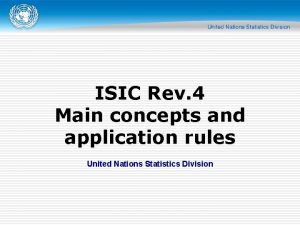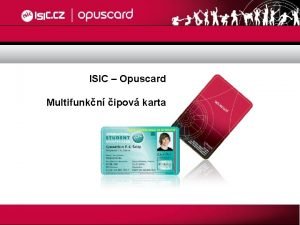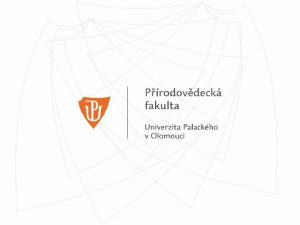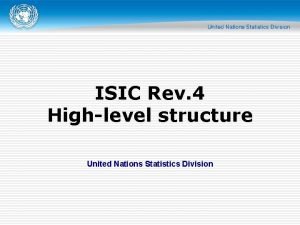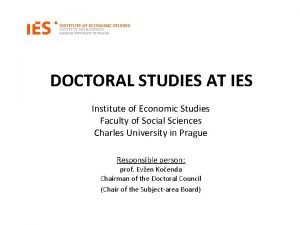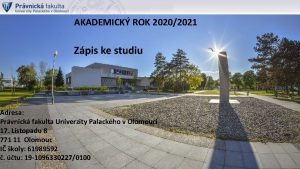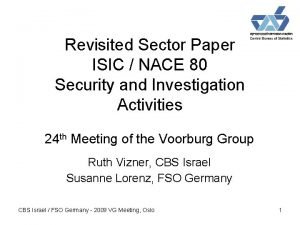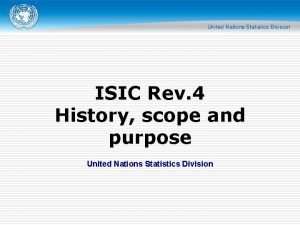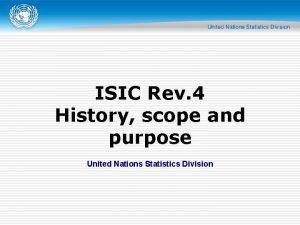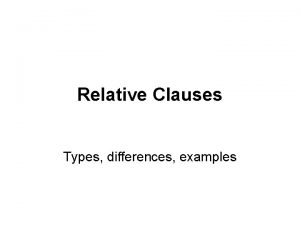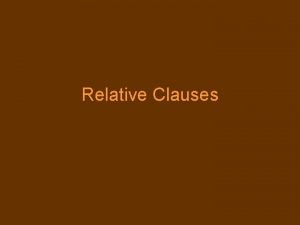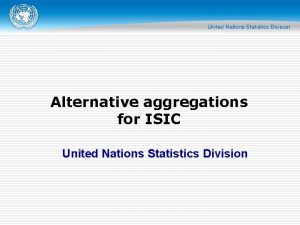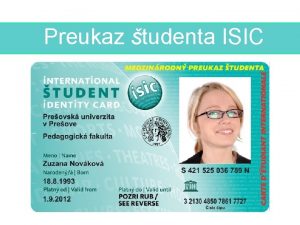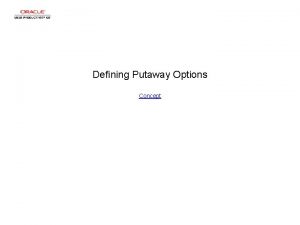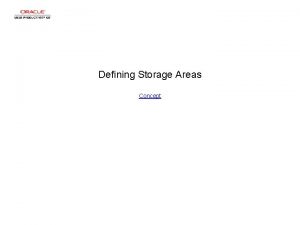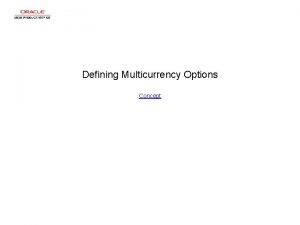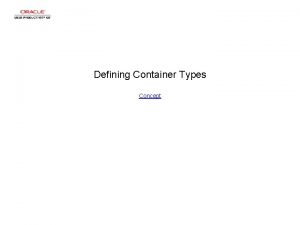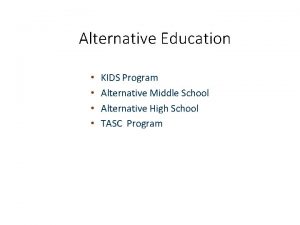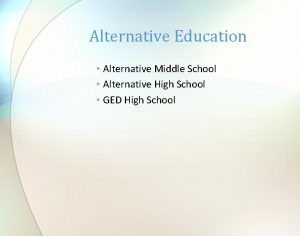Defining alternative aggregations for ISIC Example of the



















- Slides: 19

Defining alternative aggregations for ISIC: Example of the Blue Economy United Nations Statistics Division EXPERT GROUP MEETING ON INTERNATIONAL STATISTICAL CLASSIFICATIONS 6 -8 September 2017, New York

Outline – Concept of alternative aggregations – Current practice – Blue economy concept • Definition • Data sources / classifications – Role of EGM / Next steps

Concept of alternative aggregations – Any statistical classification reflects compromises between a number of theoretical principles and practical considerations. Thus, not all needs for aggregated data will be equally well served by simple aggregation through the various levels within the existing structure of ISIC. – To meet specialized needs, standardized alternative aggregations can be formed – Intended to serve the needs of a group of users who wish to present data that are classified according to ISIC in terms of standard tabulation categories that are essentially user-defined and internationally recognized – General goal: use complete ISIC classes – However, for some concepts not possible / sufficient • Still possible to give a definition in terms of an alternative aggregation using partial ISIC classes, while the actual data conversion would need to be supplemented by additional information. – Example: Green Economy

Current Alternative aggregations for ISIC Rev. 4 – 4 such aggregations have been published in the ISIC 4 manual: • Alternative aggregation for the information economy – ICT sector definition – Content and media sector definition • Alternative aggregations for SNA data reporting • Alternative aggregation for data reporting on the informal sector • Alternative aggregation for data reporting on the nonprofit institutions sector

Example: Information economy • Very important topic when ISIC 4 was developed • Defines the scope of the information economy in statistical terms – Supplemented by CPC alternative aggregations • Cooperation with the WPIIS to arrive at this aggregation – Intent was to use complete ISIC classes – Required some modifications in ISIC


Blue Economy / Ocean Economy • In addition to the differing terminology (see also ESA/STAT/AC. 340/17), there is still no universally accepted definition of the ocean economy. • This may also translate into different demands for the ISIC structure and detail (Following information based on: The Ocean Economy in 2030 (OECD))

Blue Economy / Ocean Economy • “The maritime economy consists of all the sectoral and cross-sectoral economic activities related to the oceans, seas and coasts. This includes the closest direct and indirect supporting activities necessary for the functioning of these economic sectors, which can be located anywhere, including in landlocked countries. ” (EC, Ecorys) • “The ocean economy are the economic activities that take place in the ocean, receive outputs from the ocean, and provide goods and services to the ocean. In other words, the ocean economy can be defined as the economic activities that directly or indirectly take place in the ocean, use the ocean’s outputs, and put the goods and services into the ocean’s activities. ” (Park) • “Any definition of the ocean economy is incomplete unless it also encompasses non-quantifiable natural stocks and non-market goods and services. In other words, the ocean economy can be defined as the sum of the economic activities of ocean-based industries, and the assets, goods and services of marine ecosystems. ” (OECD report)

Blue Economy / Ocean Economy

Blue Economy / Ocean Economy

Ocean-based industries Established Emerging Capture fisheries Marine aquaculture Seafood processing Deep- and ultra-deep water oil and gas Shipping Offshore wind energy Ports Ocean renewable energy Shipbuilding and repair Marine and seabed mining Offshore oil and gas (shallow water) Maritime safety and surveillance Marine manufacturing and construction Marine biotechnology Maritime and coastal tourism High-tech marine products and services Marine business services Others Marine R&D and education Dredging

Ocean-based industries Established Emerging Capture fisheries Marine aquaculture Seafood processing Deep- and ultra-deep water oil and gas Shipping (water transport) Offshore wind energy Ports Ocean renewable energy Shipbuilding and repair Marine and seabed mining Offshore oil and gas (shallow water) Maritime safety and surveillance Marine manufacturing and construction Marine biotechnology Maritime and coastal tourism High-tech marine products and services Marine business services Others Marine R&D and education Dredging

(Used in OECD report) Data used • UN and OECD sources are used to collect industry-specific data on physical capital stock, employment and value added for those ocean-based industries defined in ISIC Rev. 3, namely, fisheries (capture fisheries and aquaculture), fish processing, water transport (i. e. shipping), and shipbuilding and repair (excludes marine equipment). • However, not every sector that is relevant and included in the ocean economy is defined as such within the ISIC and national statistical accounts. The 3 - and 4 -digit level ISIC codes are not detailed enough to list all the ocean-based industries mentioned above. For this analysis, ISIC data from Rev. 3 were used since there are more countries reporting to Rev. 3 than to the newer version Rev. 4

Data used (Used in OECD report) • Distinction of methods based on ISIC definition: – Two different approaches are developed to estimate the current value of the ocean economy for two sets of oceanbased industries: ocean-based industries defined by the ISIC Rev. 3 and ocean-based industries that are not defined by the ISIC Rev. 3. • Data adjustments were used: – The ISIC Rev. 3 code “ 6110” for water transport (shipping) contains the transport of passengers and freight, which also includes cruise tourism. Consequently, value added and employment in cruise tourism were estimated and excluded from water transport in order to avoid double counting.

Data used (Used in OECD report) • Recognized need for using new classifications: – it would be helpful if more countries were to use ISIC Rev. 4 as the statistical classification system for the ocean economy, including also emerging ocean-based industries, and separating ocean-based from land-based activities – The main data source used for aquaculture, “ISIC Rev. 3”, code “ 05 fisheries”, reports on the combined national fish production but does not distinguish between capture fisheries and aquaculture. (Using value added data from other sources for this split may lead to errors in estimating employment data. )

Blue Economy / Ocean Economy • Can we describe this in terms of an ISIC aggregation? – Some industries match exactly – Others would need changes in ISIC • If we want to use just complete classes for the aggregation • Should this be done to support statistical measurement of the Blue Economy? – Relying on one specific definition of BE

Next steps (1) • This example leads to a number of general questions: – How do we decide for which topics alternative aggregations should be produced? • What sources do we use to get suggestions and determine importance? – When do we agree to make changes to ISIC to support such aggregations? • To enable aggregations of full ISIC classes

Next steps (2) • Do all aggregations have to be approved by the EG (or someone else)? – Or do we leave definition and publication to any interested user? – Where do we draw the line (if there is one)? – What would our procedure be? • What would be the appropriate distribution channel? • Do we still develop alternative aggregations for old versions of ISIC?

Thank you
 Relative pronouns defining and non-defining
Relative pronouns defining and non-defining Relative clauses defining and non defining
Relative clauses defining and non defining Non defining
Non defining Defining and non defining relative clauses in telugu
Defining and non defining relative clauses in telugu Tipos de relative clauses
Tipos de relative clauses Essential adjective clause
Essential adjective clause Isic rev 4
Isic rev 4 Isic opuscard
Isic opuscard Akademický rok
Akademický rok Isic rev 4
Isic rev 4 Aaem plc
Aaem plc Elektronická nástěnka pf upol
Elektronická nástěnka pf upol Voorburg group
Voorburg group Nace isic
Nace isic Isic nace
Isic nace Isic karta
Isic karta Isic rev.4
Isic rev.4 Isic rev 4
Isic rev 4 Relative clauses types
Relative clauses types Defining sentence example
Defining sentence example






